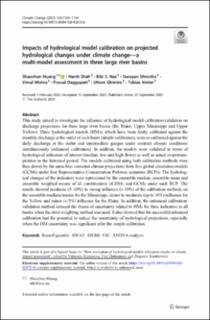| dc.description.abstract | This study aimed to investigate the influence of hydrological model calibration/validation on discharge projections for three large river basins (the Rhine, Upper Mississippi and Upper Yellow). Three hydrological models (HMs), which have been firstly calibrated against the monthly discharge at the outlet of each basin (simple calibration), were re-calibrated against the daily discharge at the outlet and intermediate gauges under contrast climate conditions simultaneously (enhanced calibration). In addition, the models were validated in terms of hydrological indicators of interest (median, low and high flows) as well as actual evapotranspiration in the historical period. The models calibrated using both calibration methods were then driven by the same bias corrected climate projections from five global circulation models (GCMs) under four Representative Concentration Pathway scenarios (RCPs). The hydrological changes of the indicators were represented by the ensemble median, ensemble mean and ensemble weighted means of all combinations of HMs and GCMs under each RCP. The results showed moderate (5–10%) to strong influence (> 10%) of the calibration methods on the ensemble medians/means for the Mississippi, minor to moderate (up to 10%) influence for the Yellow and minor (< 5%) influence for the Rhine. In addition, the enhanced calibration/validation method reduced the shares of uncertainty related to HMs for three indicators in all basins when the strict weighting method was used. It also showed that the successful enhanced calibration had the potential to reduce the uncertainty of hydrological projections, especially when the HM uncertainty was significant after the simple calibration. | en_US |

